GIA Explained: The Ultimate Guide to Understanding Property Size
In the world of real estate, where every square foot or square meter counts, it’s important to understand the ins and outs of GIA (Gross Internal Area).
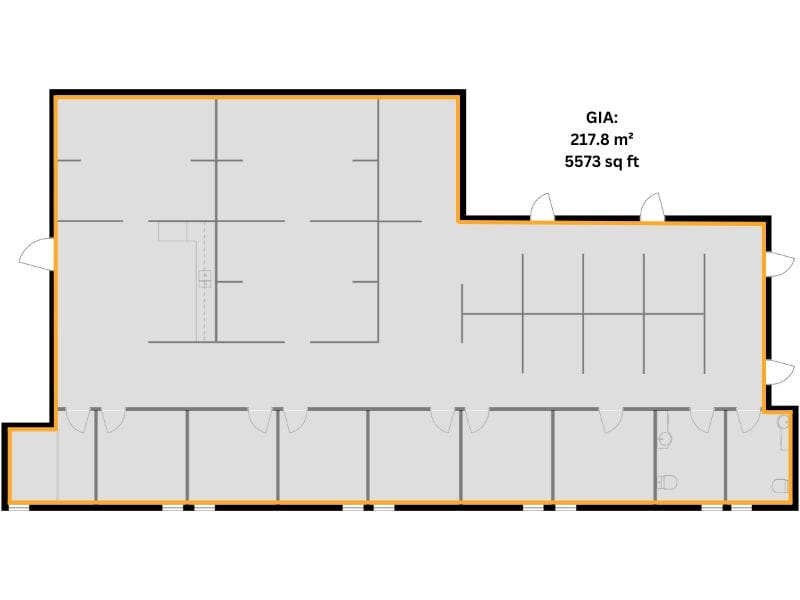
GIA is a standard measurement system used in many countries to measure the internal floor area of a building. This article explains what GIA is, how it differs from other measurement standards, how to calculate GIA, and more.
What is Gross Internal Area (GIA)?
GIA (Gross Internal Area) is the total internal floor area of a building and may also be referred to as Gross Internal Floor Area (GIFA). The Gross Internal Area (GIA) is measured to the inside face of the exterior walls and includes all of a building’s floors, both above and below ground. GIA generally includes internal walls or partitions and common building features such as stairs, elevators, hallways, restrooms, storage rooms, machinery rooms, garages, and basements.
Note that definitions of GIA - including which areas count towards it and which don’t - vary slightly worldwide. Hence, it's best to check with local authorities or a professional appraiser for the most accurate information for your location. Also, when a real estate listing uses GIA, it may refer to the finished GIA and have a disclaimer attached to specify the included areas.
Practical Tips on How to Measure and Calculate GIA
Following these steps will enable you to measure and calculate Gross Internal Area for property assessments and real estate transactions.
Option 1: Use an existing blueprint or floor plan
If you have an existing blueprint or floor plan for the building, you can import it into floor plan software like RoomSketcher, and the software will calculate the GIA for you.
Option 2: Measure onsite
You can also measure up the property if you don’t have access to an existing floor plan.
- Start with a walkaround - Walk around inside the property to get an idea of the shape.
- Sketch the external walls on paper or tablet - Make a sketch of the property shape on paper or create a digital sketch using floor plan software on your tablet. Be sure to note key internal wall lengths. At this point, you can import the sketch into floor plan software, and the software can calculate the GIA.
Or, if you want to measure by hand: - Find the rectangles - Note whether the building is a simple rectangle or break it down into smaller rectangles (so that you can multiply length x width for each rectangle and add them together).
- Get the measurements - Use a tape measure, roto wheel, or a laser to determine the size of each rectangle inside the property. Measure from the inside of one exterior wall to the opposite exterior wall. If internal walls are in the way, measure to the nearest one, note its width, and then continue to measure. Be sure to document and include internal wall widths in the measurement. Once you’ve measured up one side of a rectangle, go ahead and measure the other direction.
- Do the math - Multiply the length and width of each rectangle to calculate its size. Add together all the rectangular areas on the floor. Repeat for all floors, and sum the result to calculate the building’s GIA.
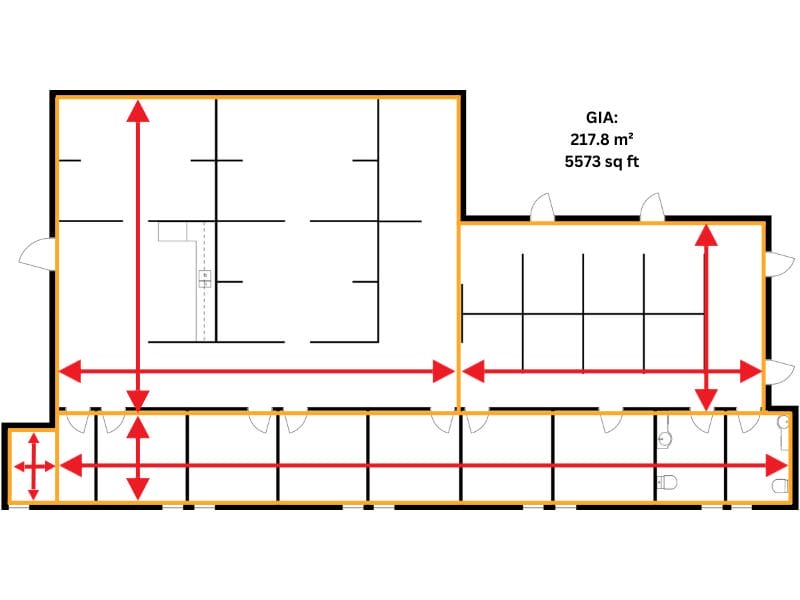
Bonus Tip! Use Software to Double-Check Your Calculation
Once you’ve manually calculated the GIA of a building, here’s a way to double-check your work. Pick floor plan software like RoomSketcher, where you get a built-in total area calculator that you can use to double-check your measurement. If everything matches up, then great! If your GIA and the RoomSketcher GIA are way off - you should go back to the property to double-check your measurements.
What Areas are Included in a Gross Internal Area Calculation?
GIA describes how much interior space is available in a building, both above and below ground. Examples of areas to include in the GIA calculation are:
- All areas inside the building, including internal walls and partitions.
- All floors and levels, both above and below ground.
- Basements and garages.
- Entrance halls and atriums.
- Mezzanine floors, internal open-sided walkways, and balconies.
- Internal projections such as pillars, columns, piers, stairwells, lift-wells (elevator-wells).
- Internal corridors.
- Voids on upper floors over stairwells.
- Equipment rooms, fuel stores, etc., if they are housed in a permanent and covered structure. It does not matter if they are above the main roof level.
- Service rooms, including common area toilets, restrooms, and changing rooms.
What Do You Exclude from GIA Measurements?
Since GIA is a measure of internal space, a building’s external walls and other external items are not included in GIA measurements.
Examples of areas that are not included in the GIA calculation are:
- Perimeter or external walls.
- External projections such as an uncovered balcony or patio area.
- External open-sided walkways or fire escapes.
- Canopied areas.
- In residential properties: greenhouses, conservatories (external rooms with mostly glass walls and roofs), garden sheds, fuel stores, etc.
In addition, in some locations, GIA includes only finished floor areas, so it’s always a good practice to check the relevant guidelines in your area.
Specific GIA Measuring Tips for Commercial Properties
If a commercial building has an atrium, stairwells, upper walkways, etc., the specifics of what should be included or excluded in GIA measurements can be tricky. Here are some examples to clarify when to include a specific area.
Atriums, stairways, and walkways: An atrium is a glass-roofed interior sky-lit area, often located at the entrance or center of a building and surrounded by multiple floors or levels.
- When calculating GIA, voids over an atrium are not considered part of the upper floor, unlike voids over stairwells, which are included in a GIA calculation.
- When an atrium is part of the building's entrance feature and has a staircase, it does not become a stairwell but remains an atrium. That means it is only measurable at the base floor level.
- Walkways at an upper level that cross an atrium are part of the upper floor measurement.
Rooftop Space: Roof space is typically not included in GIA measurements. However, areas in a roof space that have permanent access are included in the upper floor measurements. Such roof spaces should be measured to the internal face of the external wall.
What Is the Difference Between Gross Internal Area (GIA) and Gross Living Area (GLA)?
Both GIA and GLA can be used to ascertain the area of a property. However, they are not the same, and as property size is often crucial to determining the value of a property, it is important to know the difference between the two.
- Gross Living Area (GLA) includes the total above-ground (or above-grade) residential living space. GLA excludes below-ground areas, above-ground finished attic space, and finished living space above a garage if it is not directly accessible from the main living space.
- Gross Internal Area (GIA) includes all space: above-ground, below-ground, in an attic, and over a garage.
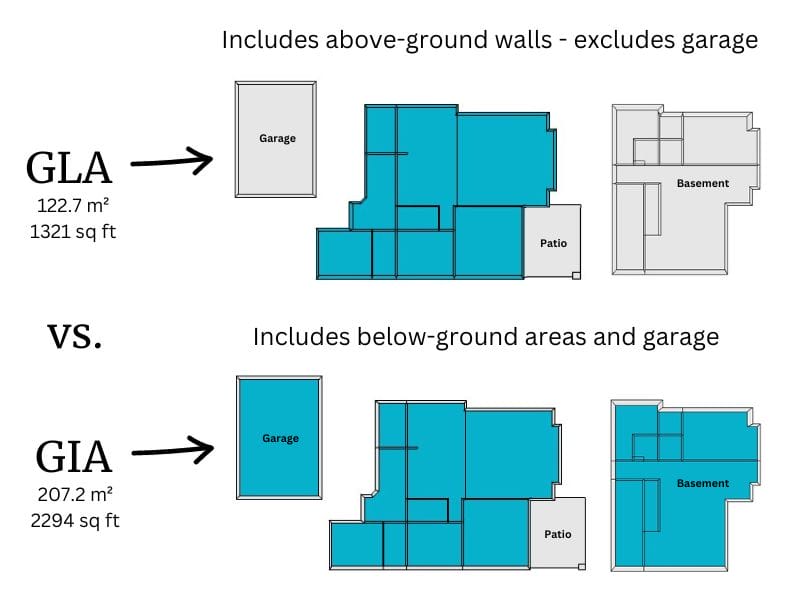
The Differences Between Gross Internal Area (GIA) and Net Internal Area (NIA)
As well as knowing the differences between GIA and GLA, real estate professionals should know the difference between GIA and NIA (Net Internal Area).
NIA focuses on useable space within a commercial building. Tenants leasing a commercial property are interested in the usable space since that’s where they can fit cubicles, desks, supplies, inventory, and equipment.
You take measurements for NIA in the same way as for GIA but subtract certain elements such as:
- Internal walls.
- Stairwells and elevator spaces.
- Machinery rooms occupied by permanent heating, cooling, air conditioning, and boiler equipment.
- Common area toilets, restrooms, and cleaners' equipment rooms.
- Any area controlled by, say, the property manager. This could be the entry lobby, for example.
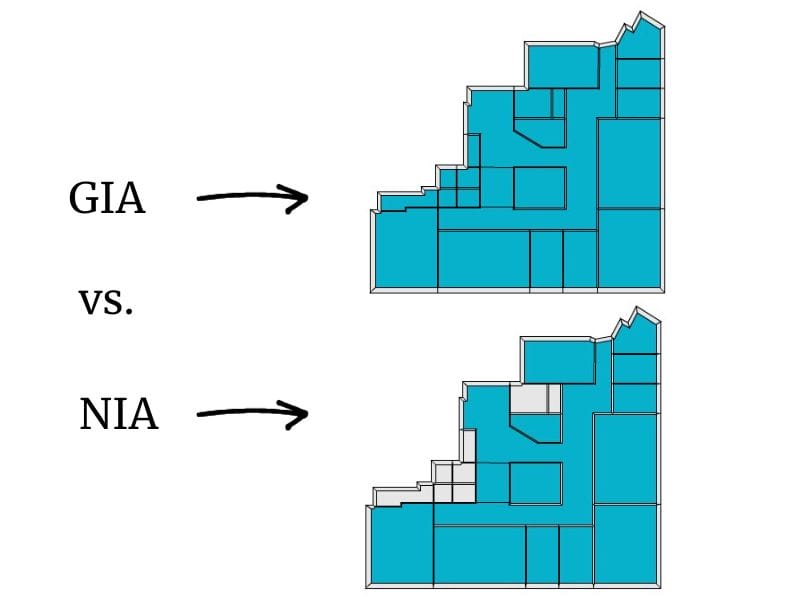
When Should You Use GIA, GLA, or NIA Measurement Standards?
GIA and GLA measurements may be used to represent the size of both residential and commercial properties in your area. NIA measurements are generally only used with commercial properties such as retail spaces and office buildings.
- Real estate agents typically use GIA measurements because they include the total living area, whether the rooms are above grade or below, as with a finished walk-out basement.
- Above-grade areas are more valuable than below-grade areas, so an appraiser will likely calculate the GLA and the GIA when valuing a property.
- Some tax authorities focus on GLA measurements in their calculations.
GIA is typically used to:
- Calculate building costs and apportion property management charges to multi-unit occupants.
- Determine the market value of a property, especially industrial, offices, warehouses, retail, and department stores.
- Value new homes, excluding conservatories, exterior balconies, and sometimes garages.
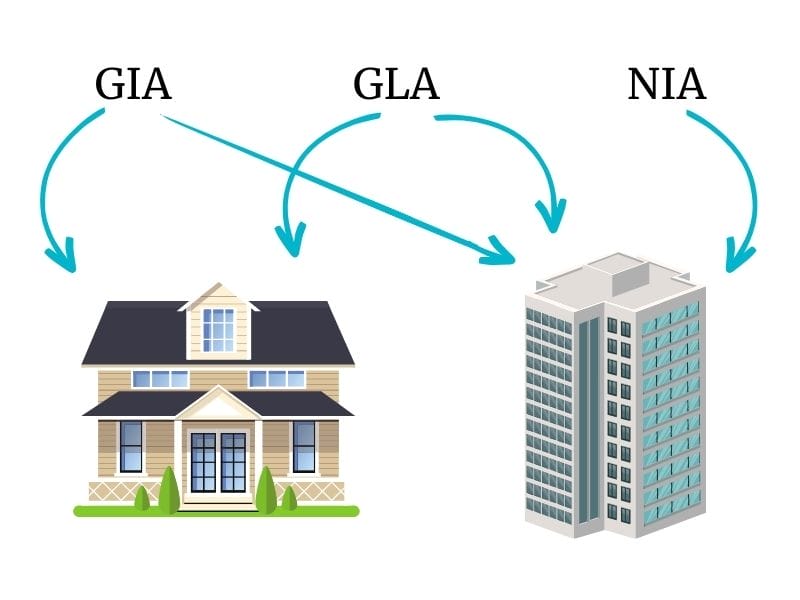
Potential Problems from Not Knowing the Difference Between GIA and GLA
GLA only includes above-ground floor space. If a potential buyer or tenant is looking for a property with, say, 3000 sq ft (279 m2) of floor space, but their agent searches for properties by GLA, the search could produce properties with a 3000 sq ft above ground space, but much higher total floor space because they include a sizeable below-ground space.
The reverse would also be true. A client who wants a GLA of a specific size, because they need that much above-ground finished space, would be disappointed to find their agent had searched using GIA parameters. The total finished area may be correct, but half could be below ground or include attic space.
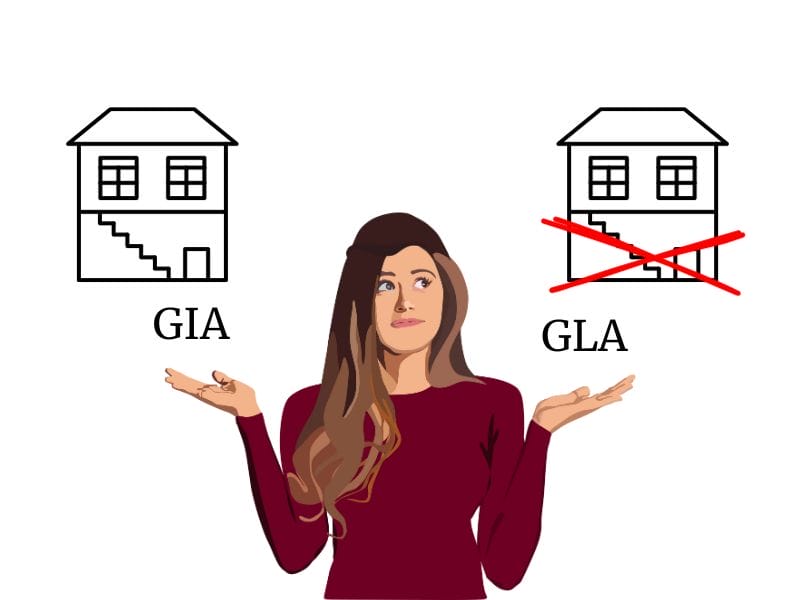
Another potential problem is valuing a property for sale. Above-ground areas are considered more valuable than below-ground areas. Suppose a real estate agent measures the property's GIA but records it as GLA. When a lender's appraiser comes to value the property to approve a mortgage, the value will fall short because the actual GLA (or more valuable part of the property) is smaller.
All real estate professionals must use consistent terms and measurements to avoid confusing lenders, buyers, agents, and property owners who may become involved in the transaction.
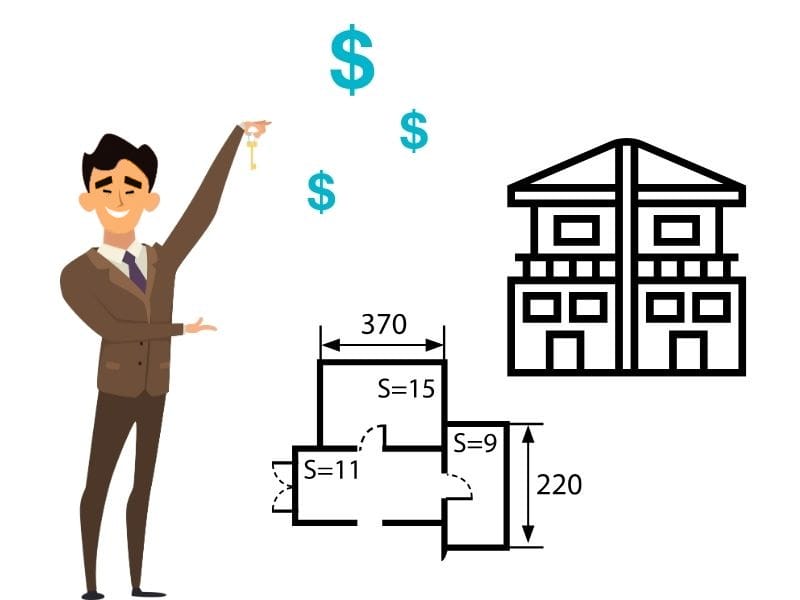
Get Confident in your Understanding of Gross Internal Area
Precision in property measurement is paramount in the world of real estate. As a professional, you will want to be confident that the measurement you have is accurate, both so you place the correct number on your listing and also so that you can give a precise estimation of the property value.
With floor plan software, such as RoomSketcher, you have a powerful tool at your fingertips to help you make sure your GIA calculation is accurate.
Don't forget to share this post!
Recommended Reads
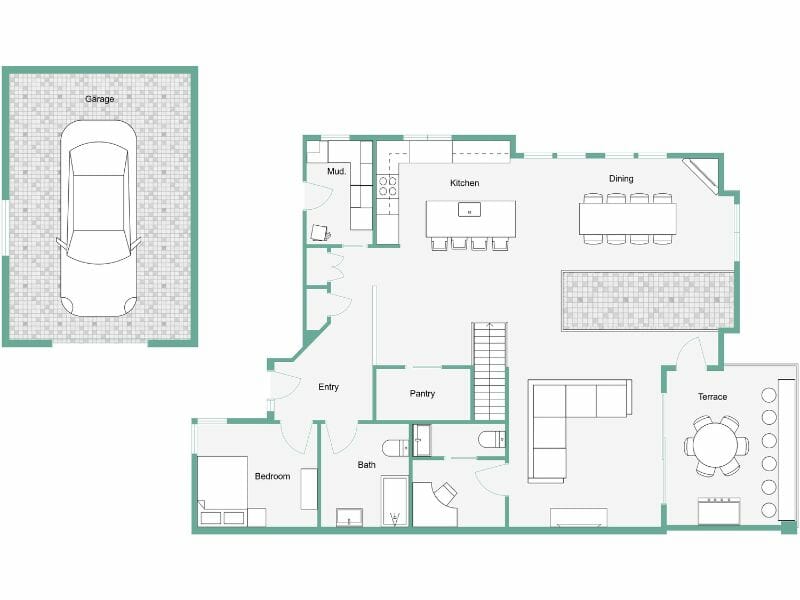
What is Gross Living Area (GLA) and How Do You Calculate It?
Learn what Gross Living Area (GLA) means, why it's important, and how to accurately calculate it for a property. Discover our expert guide.
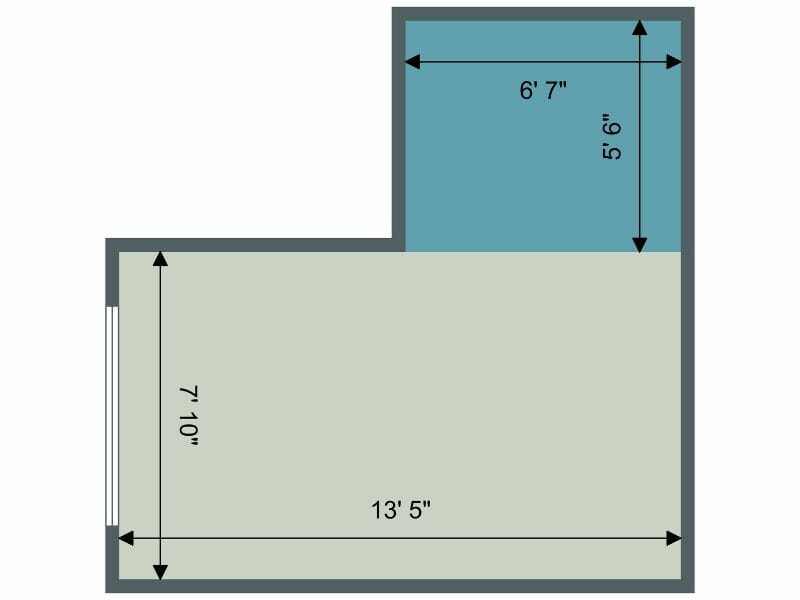
How to Measure Floor Area
Measure floor areas easily, quickly, and accurately. The correct results are essential for ordering materials for renovation projects, preparing sales and marketing materials for a property, and designing the furniture layout.
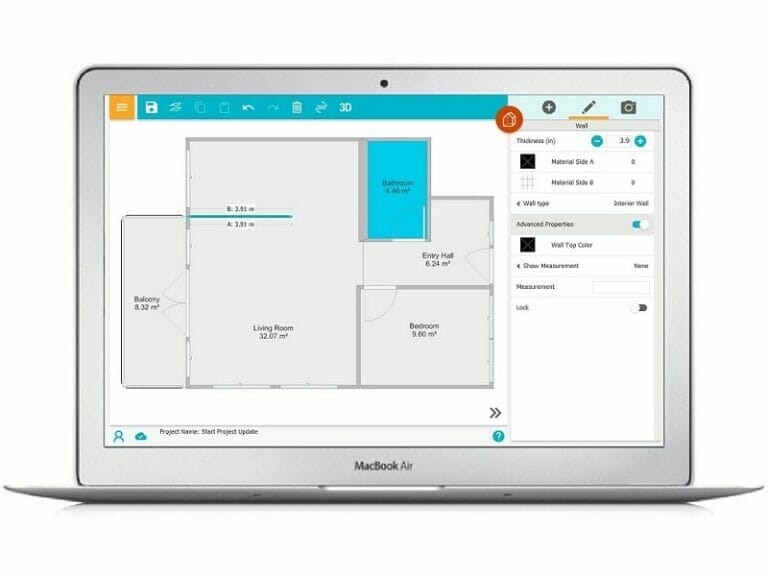
Why RoomSketcher Is the Best Floor Plan Tool Out There
After careful research, we highly recommend RoomSketcher as the best floor plan tool available. Learn the reasons why RoomSketcher stands out.
